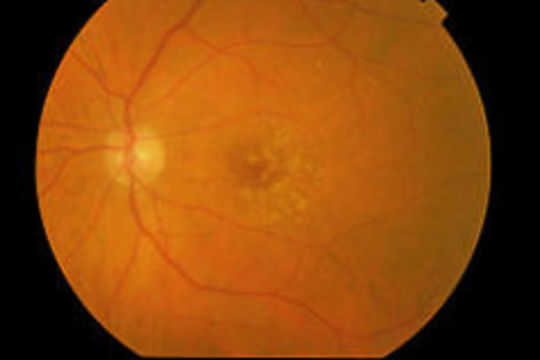
Age-related macular degeneration (AMD) is the main cause of blindness in Australia. One in seven people aged over 50 have some signs of macular degeneration.
You are reading this article because of your macula, which is the part of the eye affected by macular degeneration. The macula is the central part of the retina or back of the eye that allows you to see fine detail.
In some people, macular degeneration progresses so slowly they don’t notice the change in their vision. In others, the disease progresses faster leading to vision loss in one or both eyes.
The substantial visual impairment linked with age-related macular degeneration means patients have reduced ability to engage in everyday activities, such as reading and driving.
This can result in major disability and be a burden to the person and the health care system.
Forms and causes
Age-related macular degeneration has two forms: wet and dry. Dry is the most frequent and leads to gradual loss of vision.
 Small whitish-yellow blobs of fat and protein called drusen on the macula is an early sign of macular degeneration. Community Eye Health/Flickr, CC BY
Small whitish-yellow blobs of fat and protein called drusen on the macula is an early sign of macular degeneration. Community Eye Health/Flickr, CC BY
The most common early sign of dry macular degeneration is the presence of small whitish-yellow blobs of fat and protein called drusen on the macula.
These naturally occur as part of the ageing process and are believed to be the result of the eye’s failure to eliminate waste products in the cells of the eye.
In the early stages, drusen are small and few and don’t affect vision. But as these blobs become larger, most people report reduction in their central vision.
The wet form of age-related macular degeneration is responsible for most of the condition’s severe visual loss but is much less common. It is caused by the growth of abnormal blood vessels that leak and scar underneath the retina. Both the wet and dry forms are painless.
It is currently unclear exactly what causes the processes that lead to macular degeneration, which can make it difficult to prevent.
Age is the strongest known risk factor and the disease is more likely to occur after 50, although it can occur earlier. Cases of macular degeneration have been seen in people in their thirties but this is uncommon.
There is also such a thing as juvenile macular degeneration, which is a series of inherited eye disorders affecting children and young adults – but this is considered different to the age-related form.
A family history of macular degeneration can increase the risk of getting the disorder by 50%. Studies have shown macular degeneration is more common in women than men as well as in people of Caucasian and Chinese ethnicity than other ethnic groups.
Smoking is another known risk factor. Studies have demonstrated smokers have up to three or four times the risk of getting macular degeneration than non-smokers.
Symptoms and diagnosis
The main symptom of age-related macular degeneration is visual distortion: straight lines appear wavy or bent. People with AMD may also experience difficulty in activities that require fine vision, such as reading or recognising faces.
People with macular degeneration can develop dark patches or blind spots in the centre of their vision.
Symptoms of dry macular degeneration can take five to ten years to become severe. Wet AMD, however, can develop more quickly leading to severe visual loss.
Macular degeneration can be diagnosed by an ophthalmologist who may recommend the Amsler grid test. This is when a special piece of paper with horizontal and vertical lines is used to check visual fields. If any section of the lines is missing or distorted, macular degeneration is a possible cause.
The ophthalmologist will then examine the back of the eye with a slit lamp (a high-intensity light source) microscope and take digital photographs of the retina.
A non-invasive test called ocular coherence tomography uses light waves to scan the retina. It can give a detailed 3D-picture of the macula and show if there are any abnormalities.
Treatment and prognosis
There is currently no cure for macular degeneration but treatments are now available for the wet form. These are aimed at maintaining vision for as long as possible and preventing progression of the disease.
The main treatment for wet age-related macular degeneration is anti-vascular endothelial growth factor (anti-VEGF) medication. This medication blocks the VEGF, a protein that stimulates blood vessel growth, and prevents the growth of new abnormal blood vessels in the retina.
In some patients, laser surgery can also be used to destroy abnormal blood vessels. Early detection and treatment of wet AMD is vital to reduce the risk of severe vision loss and possibly blindness.
Treatment for dry macular degeneration aims to maintain the best vision for as long as possible. Some ophthalmologists recommend antioxidant supplements to minimise progression – particularly zinc, vitamins C and E and beta carotene.
Quitting smoking can also prevent or slow the progression of dry macular degeneration. A balanced diet of adequate fish intake and dark leafy green vegetables and fruits is recommended.
You can also reduce the risk of age-related macular degeneration by protecting your eyes; wearing sunglasses that have lenses that block and absorb UV rays when outside for long periods of time.
About The Author
Bamini Gopinath, Principal Research Fellow, Sensory Loss Epidemiology, Westmead Institute, University of Sydney
This article was originally published on The Conversation. Read the original article.
Related Books
at InnerSelf Market and Amazon
























